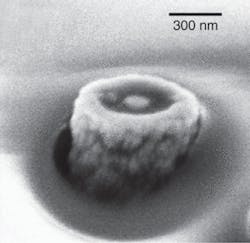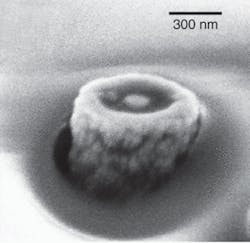Nanophotonic coaxial waveguid channels visible light
Physicists at Boston College (BC; Chestnut Hill, MA) have shown that a nanoscale coaxial waveguide can guide visible light. The waveguide propagates light in the TEM mode of a coaxial waveguide, but measures only 300 nm in diameter. The inner conductor is a carbon nanotube, aluminum oxide forms the dielectric layer, and coatings of aluminum or silicon replace the outer shielding. A length of the nanotube projects from the end, serving as an optical antenna that coupled light at 532 or 680 nm into the waveguide. The researchers fabricated waveguides 6 to 20 µm long, and estimate that the weakly dispersive mode should propagate roughly 50 µm at visible wavelengths. Conductors were chosen to avoid plasmon resonances at visible wavelengths, because the surface waves can propagate only a micrometer or two.
Developers are exploring a wide range of possible applications and filing patent applications. In the first application to be tested, the dielectric layer will be replaced with a photovoltaic material that would absorb the light and convert it into electricity, says Michael Naughton, head of the BC physics department. He hopes a densely packed structure could beat the efficiency of the best conventional solar cells. Contact Krzysztof Kempa at [email protected].

